Your cart is currently empty.
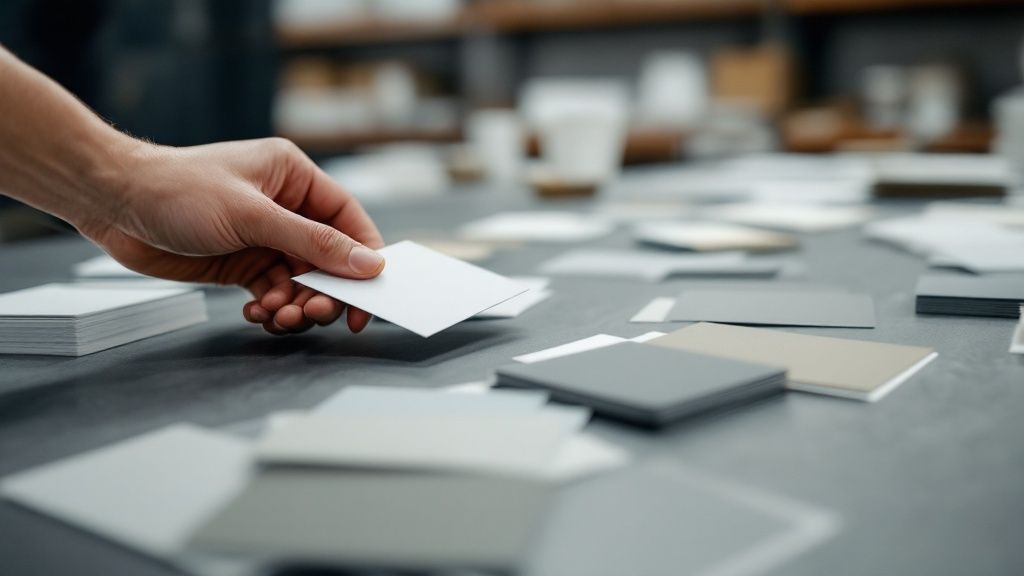
For a lot of Kiwi small and medium-sized businesses (SMEs), getting business cards sorted often means heading straight to Warehouse Stationery. It's easy to see why it's the go-to choice – it's accessible, the online tools are a breeze to use, and the price is right for anyone keeping a close eye on the budget. It’s a solid, practical starting point for getting professional cards in hand without any fuss.
Why Warehouse Stationery Is a Smart Choice for Kiwi SMEs
Let's be honest, for startups and established businesses alike here in New Zealand, it often just boils down to convenience. You’ve got stores dotted all over the country and an online system that’s dead simple to use. Kicking off an order is straightforward, and you certainly don't need to be a graphic designer to figure out their templates. This is a huge plus for business owners who are already juggling a dozen other tasks.
Their sheer scale is another big draw, especially when it comes to keeping costs down. Placing a bulk order for your whole team is far more economical than doing small runs, which is a massive consideration for any SME working to make every dollar count. A local print shop might offer those fancy bespoke finishes, but the template-based system from a big retailer like this delivers consistency and speed – and often, that’s exactly what you need.
Balancing Cost and Customisation
The real decision here is weighing up that efficiency against the desire for deep customisation. Warehouse Stationery is fantastic at delivering a professional, reliable product, and fast. The Warehouse Group is a giant in the stationery game, and while their stationery division pulled in sales of NZD 226 million in FY25, their business model is built around volume and standardisation. You can dig into the details of The Warehouse Group’s market performance and sales figures on nzx.com.
That focus on standardisation means you know what you're getting, every single time. But, if your brand really needs to make a unique, tactile statement – think embossed logos or custom shapes – then you might find a specialist printer is a better fit in the long run.
Think of your business card as a physical handshake. Deciding between a major retailer and a local printer really comes down to what you need right now: widespread, consistent branding or a unique, high-touch first impression.
And while a great business card is a fantastic physical tool, it works best when it's part of a bigger picture. For more ideas on how to build a well-rounded strategy, check out these small business marketing tips.
Navigating the New Zealand Print Market
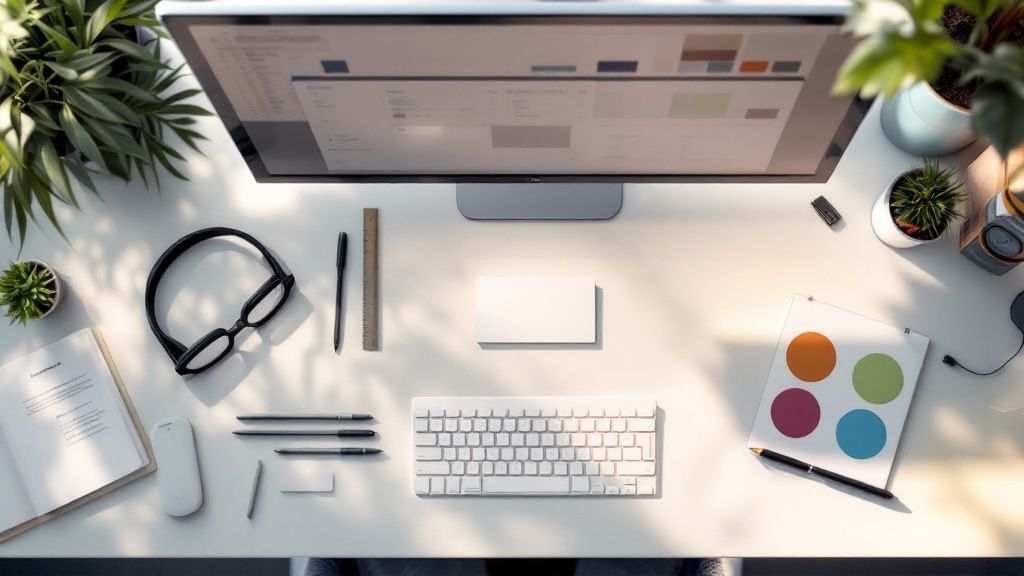
Before you lock in a big order for warehouse stationery business cards, it pays to get a feel for the print market here in New Zealand. It’s a dynamic space, and you’ll find that major players like The Warehouse Group have a pretty big say in what’s available, how fast you can get it, and what you’ll pay.
For small businesses, this concentration in the market is a double-edged sword. On one side, you get a straightforward, accessible process with reliable results – perfect if you just need cards sorted quickly and efficiently. But on the other, it’s part of a bigger picture that's putting the squeeze on smaller, independent printers across the country.
The Shift in Local Printing Options
You might not have noticed, but New Zealand's stationery retail scene has been changing. We’ve seen a slow but steady decline in the number of businesses, dropping to around 202 operators in 2025, down from 213 just a few years ago. That’s an average annual drop of 2.2% between 2019 and 2024, largely driven by shifts in how we all shop. If you’re interested in the numbers, you can dig into these stationery retail business trends on ibisworld.com.
So, what does this shrinking pool of independent shops actually mean when you need to print business cards? It can affect everything. You might find less variety in paper stocks or struggle to find someone local who offers specialised finishes like embossing or custom die-cutting.
When you choose a printer, you're not just buying cards; you're deciding what matters more for your brand at this moment: the efficiency and scale of a large retailer or the bespoke craftsmanship of a local specialist.
Having this context is crucial. It helps you make a strategic call that properly aligns with your brand’s goals and, of course, your budget. Knowing the lay of the land means you can either confidently go with a large provider or make a conscious decision to seek out a niche printer for something truly unique. It’s all about making an informed choice that works for your business right now and down the track.
Crafting a Business Card That Actually Gets Noticed
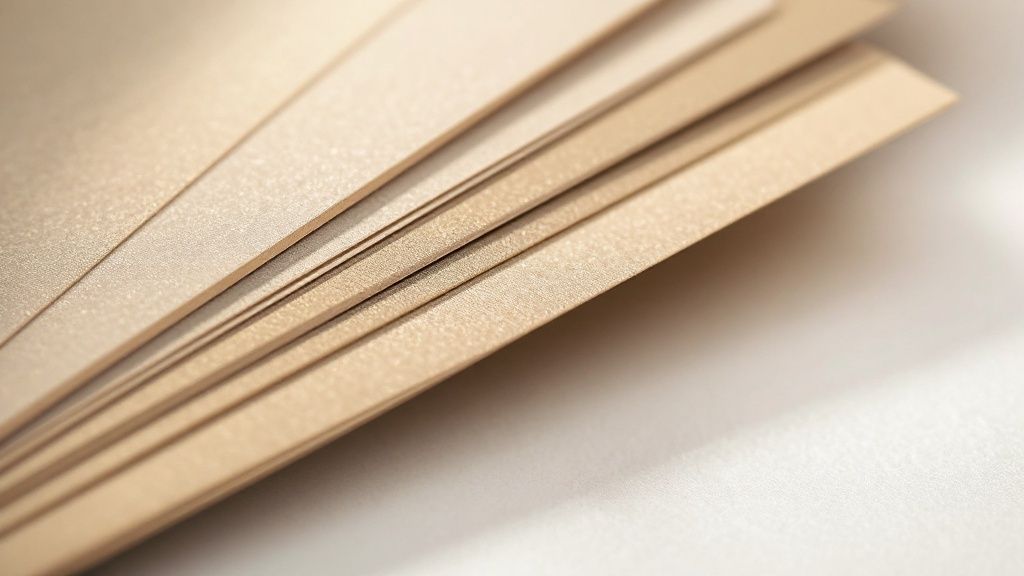
Let's be honest, most business cards are forgettable. They're a quick exchange of contact info, but rarely much more. But a great business card? It's a physical piece of your brand that someone takes with them—a tangible reminder in a world saturated with digital noise. It’s time to move beyond just listing a name and number and start creating a card that people actually want to keep.
The secret sauce is a clear visual hierarchy. This is just a fancy way of saying you guide the reader's eye to the most important information first. Naturally, your name and company logo should grab the spotlight, followed closely by your role and the best ways to reach you (phone and email are usually top contenders).
Designing for Impact
When you get down to designing your warehouse stationery business cards, think about what your brand feels like. The colours, the fonts, the overall vibe should all be a reflection of your company's personality, not just a trendy template you found online.
Here are a few things I've learned from experience:
- Font Selection: Keep it simple. Stick to one or two fonts that are a breeze to read. A classic and effective combo is a clean sans-serif for the big stuff (like your name) and a traditional serif font for the contact details.
- Colour Palette: Consistency is key. Pull colours directly from your brand's official palette. If you want to add a bit of flair, use a bright accent colour to make key information pop or to add a creative edge.
- White Space: Don't be afraid to leave some areas empty! A card crammed with text and logos looks chaotic and unprofessional. White space gives the important elements room to breathe, making your card look clean, confident, and much easier to read.
Of course, a great design is only half the battle. The words you use matter just as much. Getting some expert tips on smart copywriting for small businesses can help you craft a message that is sharp and sticks in people’s minds.
A well-designed card shows you’re prepared and you respect the interaction. It shifts a casual chat into an intentional, professional exchange, leaving a lasting signal of your credibility long after the conversation ends.
You don't need to be a professional graphic designer to pull this off. Modern online tools make it surprisingly simple to create something that looks sharp and professional. Start with a clean layout, make readability your number one priority, and let your brand's unique character do the talking.
Selecting the Right Card Stock and Finish
The way your business card feels in someone's hand says just as much as what's written on it. You can have the best design in the world, but if it's printed on flimsy paper, it instantly feels cheap. The weight, texture, and finish are all subtle cues that communicate your brand’s quality and personality. This is your chance to make a lasting first impression.
Think of it like a handshake. A flimsy, basic card is like a weak handshake—forgettable. A card with some real substance to it, a nice texture, feels professional and confident. That tactile experience creates a much stronger mental link, telling people your business is just as solid and well-considered.
What's the Deal with Card Stock Weight?
When you start looking at options, you'll see the term gsm (grams per square metre) pop up everywhere. It’s simply a measure of paper density and thickness. The higher the gsm, the thicker and more rigid the card.
For most warehouse stationery business cards, a standard 300 gsm stock is a perfectly respectable and professional choice. But if you really want to make an impact, bumping that up to 350 gsm or even 400 gsm gives your card a premium, high-end feel that people can't help but notice.
Choosing a Finish That Fits Your Brand
The finish is the final touch. It not only protects your card from wear and tear but also completely defines its final look. It’s more than just aesthetics; it affects durability and how your brand colours are perceived.
- Matte Finish: This gives you a smooth, non-reflective surface that looks clean, modern, and sophisticated. It’s brilliant for minimalist designs, and you can easily write on it—a huge practical bonus.
- Gloss Finish: A high-gloss or laminated finish makes colours look incredibly vibrant and gives your card a shiny, eye-catching look. It’s also tough as nails, offering great protection against moisture and scuffs. Perfect if your cards are going to be passed around a lot.
- Recycled Stock: Opting for a recycled paper clearly communicates your brand’s commitment to sustainability. These stocks often have a unique, slightly textured feel that can add a whole lot of character to your design.
To help you decide what material is right for your needs and budget, I've put together a quick comparison of the most common options.
Business Card Stock and Finish Comparison
| Material/Finish | Best For | Feel & Appearance | Typical Cost |
|---|---|---|---|
| 300 gsm Matte | Start-ups, everyday networking, modern brands. | Smooth, non-shiny, professional feel. Easy to write on. | $ |
| 400 gsm Gloss | Bold, colourful designs, sales teams, high-impact brands. | Thick, sturdy, and shiny. Makes colours pop. | $$ |
| Uncoated/Recycled | Eco-conscious brands, creative agencies, rustic aesthetics. | Natural, slightly textured feel. Understated and authentic. | $$ |
| Specialty (Linen, Kraft) | Luxury brands, designers, anyone wanting a unique tactile experience. | Distinctive textures that demand attention. | $$$ |
Ultimately, there's no single "best" choice—it all comes down to what fits your brand's story.
This infographic breaks down how your choice of printing method also plays a huge role in the final cost and minimum order size.
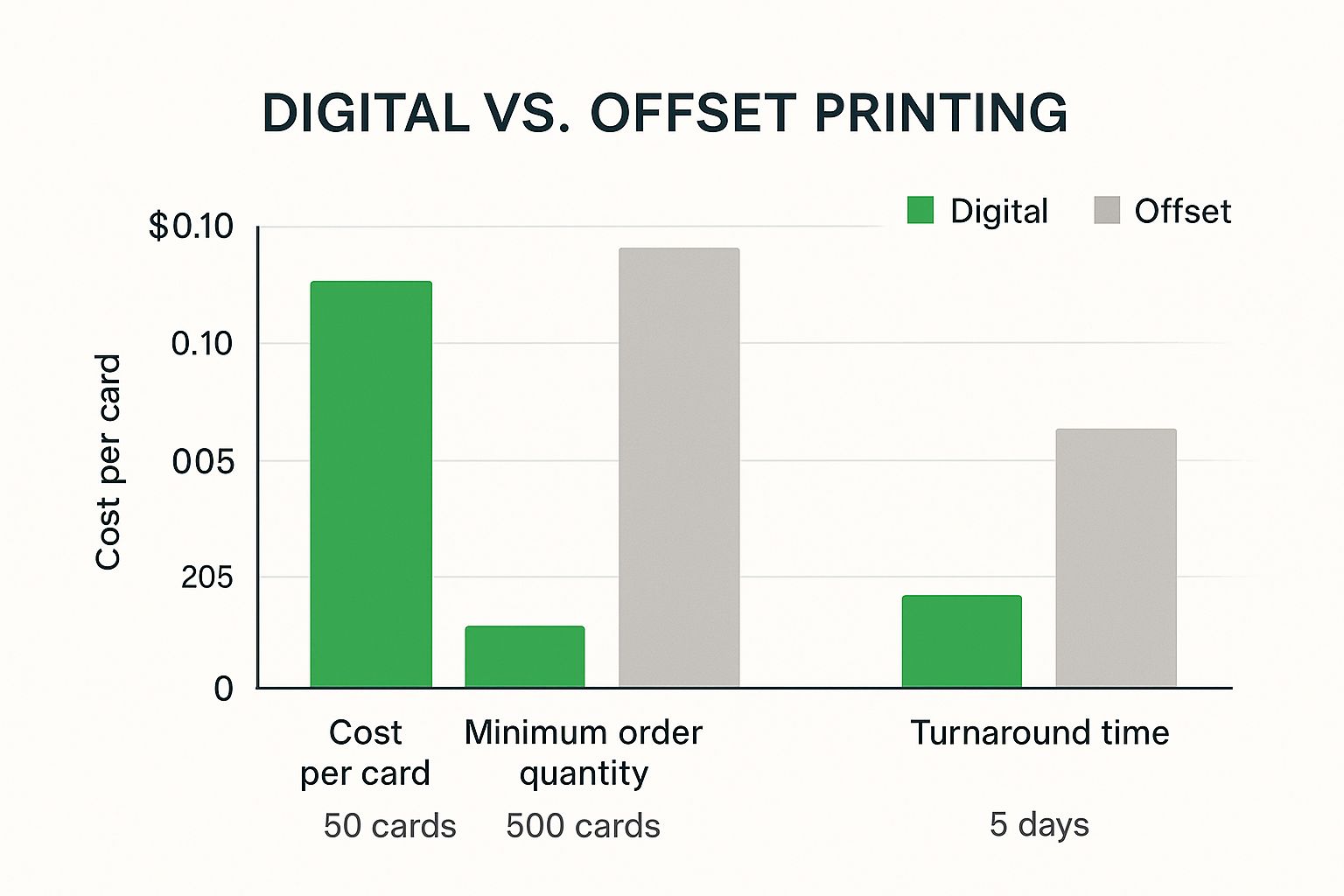
As you can see, digital printing is your go-to for smaller, quick-turnaround orders. For larger bulk orders, though, offset printing offers some serious cost savings.
Your choice of stock and finish is a direct extension of your brand identity. A creative agency might opt for a tactile, uncoated stock, while a tech company might prefer a sleek, high-gloss finish to reflect their modern edge.
My best advice? If you can, always order a sample pack from the printer. There's no substitute for actually holding the different options in your hand. It’s the only way to truly know which material best represents the quality and character of your business.
Here is the rewritten section, designed to sound like an experienced human expert:
How to Get Bulk Business Card Orders Right
Ordering a set of warehouse stationery business cards for one person is simple. Ordering them for your entire team? That’s a whole different beast. Getting this wrong can lead to wasted money and a stack of cards with inconsistent branding. Let's walk through how to turn a potential logistical headache into a smooth, repeatable system.
Your first, and most important, move is to lock down a master template. This is non-negotiable. This single template will dictate the logo placement, fonts, and colour scheme for every card that leaves the printer. It’s your single source of truth, ensuring that no matter who the card is for, it perfectly represents your brand.
Nailing Down the Team's Details
Trying to collect everyone's details through a flurry of emails is a recipe for disaster. I've found the simplest, most effective way is to use a shared spreadsheet. Set up columns for everything you need: Full Name, Job Title, Email, Phone Number, and any other fields. This keeps all the information organised in one central spot.
With all the data in one place, it’s time for the most critical step: proofing.
- Get Them to Check Their Own: Have each team member review their own details in the spreadsheet and give you a final sign-off. This puts the ownership on them to spot any typos in their name or number first.
- Bring in a Fresh Set of Eyes: Before you hit "approve," have one detail-oriented person do a final check of the entire list against the digital proofs from the printer. It’s amazing what a second person can catch.
A small typo on one business card is frustrating. The same typo printed on 500 cards for a new senior manager is a costly, embarrassing, and completely avoidable mistake. Never, ever skip that final proofread.
By setting up this process, you’re not just making this order easier; you’re creating a system. It makes reordering for new hires a breeze and ensures you can confidently take advantage of volume discounts without worrying about errors.
Common Questions About Business Card Printing
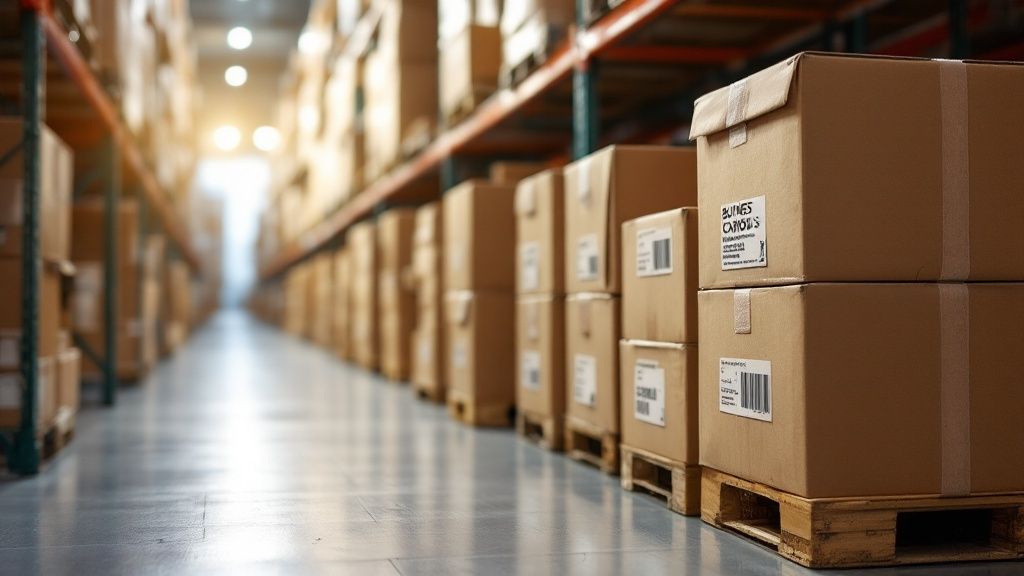
When it comes to ordering warehouse stationery business cards, a few questions pop up time and time again. Getting the right answers before you place your order can save you a fair bit of hassle and money later on. Let’s run through some of the most common queries we hear from Kiwi businesses.
The first thing everyone wants to know is, "How long will it take?" For a straightforward order on standard 300 gsm matte or gloss card, you're usually looking at about 3-5 business days for printing and delivery.
But if you start adding special touches like spot UV, foil, or rounded corners, you’ll need to allow more time. Those extras can push the timeline out to 7-10 business days. It's always best to check the estimated delivery date before you pay to make sure it works for you.
Another common question is about supplying your own design file. The short answer is yes, absolutely. Every good printer will let you upload a print-ready file. Just be aware they'll have specific requirements – usually a high-resolution PDF (300 DPI is standard) with bleed and trim marks all set up. Do yourself a favour and find their file spec sheet on their website first to avoid any back-and-forth that could delay things.
Maximising Value and Avoiding Errors
People often ask if ordering in bulk really saves money. It absolutely does. The price per card drops dramatically the more you order. For example, buying 1,000 cards in one go is significantly cheaper per card than ordering 250 cards four times. If you know you'll use them, it’s a smart way to save.
The single most common—and costly—mistake we see is rushing the proofing process. Always get a second, or even a third, pair of eyes on the final digital proof. Check every single detail: names, phone numbers, email addresses, and alignment. One tiny typo can make the whole batch unusable.
Honestly, taking an extra five minutes to triple-check everything is the best investment you can make. It can save you the cost and frustration of a full reprint.
At SONI DESIGN, we're all about bringing your brand's vision to life through high-quality print and signage that tells your unique story. From the first idea to the finished product, our team is here to create designs that truly connect. Let's work together to make something special. To get started on your next project, visit us at https://www.sonidesign.co.nz.
Leave a Comment
Stay home & get your daily
needs from our shop
Start You'r Daily Shopping with Nest Mart
Best prices & offers
Orders $50 or more
Free delivery
24/7 amazing services
Great daily deal
When you sign up
Wide assortment
Mega Discounts
Easy returns
Within 30 days
